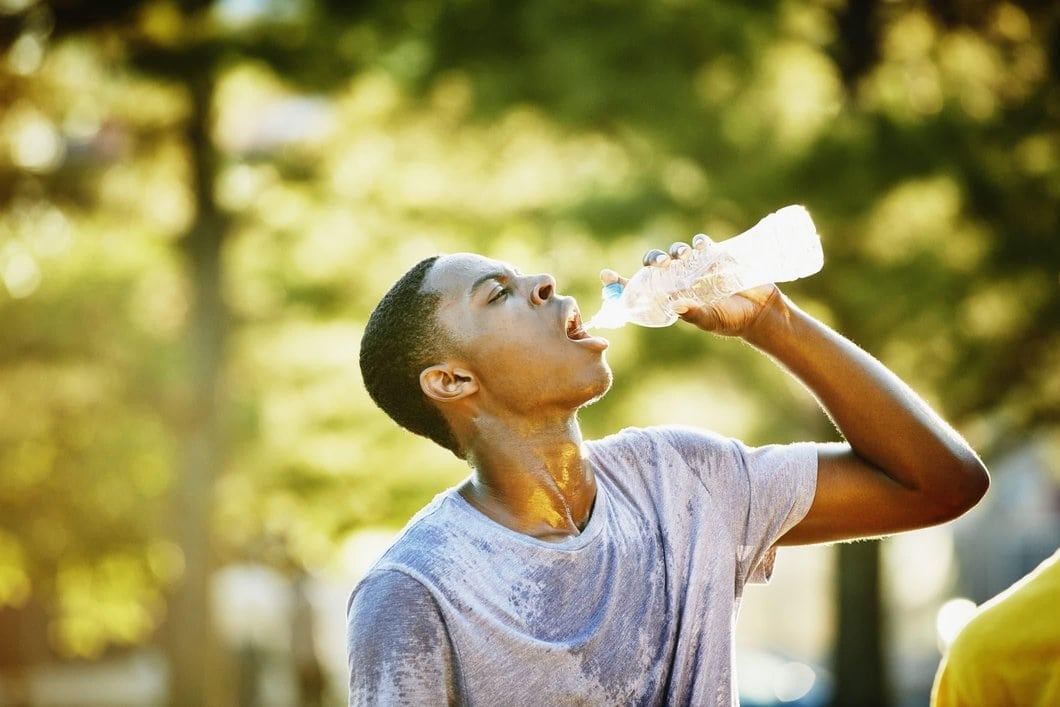Year 6 Exam > Year 6 Notes > Food & Nutrition for Year 6 > Water
Water | Food & Nutrition for Year 6 PDF Download
Introduction
- Water's Classification: Not technically a nutrient as it provides no nutrition, but vital for numerous bodily functions.
- Water Intake: Enters the body through consumed fluids and various foods.
- Hydration Role: Increases body hydration, essential for health.
- Regulation Need: Must be carefully balanced to maintain health.
- Water Loss: Exits through sweat, exhalation, and urine produced by kidneys.
- Kidney Function: Regulates blood water levels by adjusting urine output—more when water is excessive, less when scarce.
Functions of Water
- Waste Elimination: During urine production, the kidneys filter waste from the blood, including urea, a toxic byproduct of protein breakdown, which is then excreted.
- Digestive Health: Water helps prevent constipation by aiding in the movement of digested food through the intestines.
- Temperature Regulation: Water’s high heat capacity allows it to absorb significant energy when it evaporates. When body temperature rises, sweat glands release liquid sweat onto the skin, which absorbs heat from underlying blood vessels, converting to a gas and cooling the body.
- Digestion: In the mouth, water in saliva softens food into a paste for easier passage through the digestive system. In the stomach, water dilutes acid, assisting in moving digested food through the small intestine and forming feces.
- Transport: Water is a primary component of bodily fluids, such as blood, tissue fluid surrounding cells, and cytoplasm within cells. These fluids dissolve and transport essential substances and waste products throughout the body.
Consuming the Correct Amount of Water
The amount of water needed daily varies based on factors like:
- Age
- Gender
- Diet
- Physical activity levels
- Climate
In the UK, the NHS advises consuming 1.2–1.8 liters of water daily, roughly 6–8 glasses. While all fluids contribute to hydration, water is the most effective. Drinks like coffee and alcohol are less efficient at hydrating.
Approximately 20–30% of daily hydration comes from food, with 70–80% from beverages.
Risks of Improper Water Intake
- Dehydration: Insufficient water intake can cause headaches, fatigue, and dizziness.
- Water Intoxication: Excessive water consumption, though rare, can lead to cell swelling, including in the brain, potentially causing seizures and permanent damage. This typically occurs in extreme cases, such as water-drinking contests, endurance sports, or intense military training.
Drinking water in hot climates

The document Water | Food & Nutrition for Year 6 is a part of the Year 6 Course Food & Nutrition for Year 6.
All you need of Year 6 at this link: Year 6
|
67 docs|6 tests
|
FAQs on Water - Food & Nutrition for Year 6
| 1. What is the water cycle and how does it work? |  |
Ans.The water cycle is the continuous process by which water circulates through the Earth and its atmosphere. It involves several stages: evaporation, condensation, precipitation, and collection. Water from oceans, lakes, and rivers evaporates into the atmosphere, where it cools and condenses into clouds. Eventually, the water falls back to the Earth as precipitation (rain, snow, etc.), where it collects in bodies of water or infiltrates the ground, replenishing groundwater supplies.
| 2. Why is water important for life on Earth? |  |
Ans.Water is vital for all known forms of life. It serves as a solvent, transporting nutrients and waste in biological systems. Water also plays a crucial role in temperature regulation, cellular functions, and biochemical reactions. Additionally, it supports ecosystems, influences weather patterns, and is essential for agriculture and drinking.
| 3. What are some common sources of water pollution? |  |
Ans.Common sources of water pollution include industrial discharges, agricultural runoff, sewage and wastewater, oil spills, and littering. These pollutants can harm aquatic life, disrupt ecosystems, and pose health risks to humans and animals. Understanding these sources is essential for developing strategies to protect and restore water quality.
| 4. How does climate change affect water resources? |  |
Ans.Climate change impacts water resources in various ways, including altering precipitation patterns, increasing the frequency of droughts and floods, and affecting snowmelt patterns. These changes can lead to water scarcity in some regions while causing excess runoff and flooding in others, ultimately influencing water availability for drinking, irrigation, and ecosystems.
| 5. What are ways to conserve water at home? |  |
Ans.Water conservation at home can be achieved through simple practices such as fixing leaks, using water-efficient fixtures, taking shorter showers, collecting rainwater, and only running dishwashers and washing machines with full loads. Additionally, reducing lawn size, using drought-resistant plants, and being mindful of water usage when cleaning can significantly contribute to water conservation efforts.
Related Searches




















